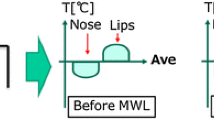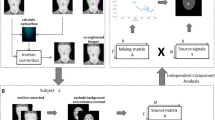When individuals who commit a crime are questioned, they often show involuntary physiological responses to remembered details of that crime. This phenomenon is the basis for the concealed information test, in which rarely occurring crime-related details are embedded in a series of more frequently occurring crime-irrelevant items while respiratory, cardiovascular, and electrodermal responses are recorded. Two experiments were completed to investigate the feasibility of using facial skin surface temperature (SST) measures recorded using high definition thermographic images as the physiological measure during a concealed information test. Participants were randomly assigned to nondeceptive or deceptive groups. Deceptive participants completed a mock-crime paradigm. A focal plane array thermal imaging radiometer was used to monitor SST while crime-relevant and crime-irrelevant items were verbally presented to each participant. During both experiments, there were significant facial SST differences between deceptive and nondeceptive participants early in the analysis interval. In the second experiment, hemifacial (i.e., “half-face” divided along the longitudinal axis) effects were combined with the bilateral responses to correctly classify 91.7% of participants. These results suggest that thermal image analysis can be effective in discriminating deceptive and nondeceptive individuals during a concealed information test.



Similar content being viewed by others
REFERENCES
Drummond, P., and J. Lance. Facial flushing and sweating mediated by the sympathetic nervous system. Brain 110:793–803, 1987.
Ekman, P. Telling Lies: Clues to Deceit in the Marketplace, Politics, and Marriage. New York: W. W. Norton & Company, 1992.
Ekman, P., W. Friesen, and S. Ancoli. Facial signs of emotional experience. J. Pers. Soc. Psychol. 39:1125–1134, 1980.
Ekman, P., W. Friesen, and P. Ellsworth. Emotion in the Human Face. Elmsford NY: Pergamon Press, 1972.
Ekman, P., J. Hager, and W. Friesen. The symmetry of emotional and deliberate facial actions. Psychophysiology 18:101–106, 1981.
Ekman, P., R. Levenson, and W. Friesen. Autonomic nervous system activity distinguishes among emotions. Science 22:1208–1210, 1983.
Ekman, P., and M. O’Sullivan. Who can catch a liar. Am. Psychol. 46:913–920, 1991.
Elaad, E., and G. Ben-Shakhar. Effects of motivation and verbal response type on psychophysiological detection of information. Psychophysiology 26:442–451, 1989.
Fox, R., R. Goldsmith, and D. Kidd. Cutaneous vasomotor control in the human head, neck, and upper chest. J Physiol. 161:298–312, 1962.
Furedy, J. J., and G. Ben-Shakhar. The roles of deception, intention to deceive, and motivation to avoid detection in the psychophysiological detection of guilty knowledge. Psychophysiology 28:163–171, 1991.
Furedy, J. J., C. Davis, and M. Gurevich. Differentiation of deception as a psychological process: A psychophysiological approach. Psychophysiology 25:683–688, 1988.
Gorbach, A. M. Infrared imaging of brain function. In: Optical Imaging of Brain Function and Metabolism, edited by U. Dirnagl, A. Villringer, and K. M. Einhaupl. New York: Plenum Press, 1993, pp. 95–123.
Grayson, J. Responses of the microcirculation to hot and cold environments. In: Thermoregulation: Physiology and Biochemistry, edited by W. C. Bowman, E. Schönbaum, and P. Lomax. New York: Pergamon Press, 1990, pp. 221–234.
Horneman, C. J., and J. G. O’Gorman. Detectability in the card test as a function of the subject's verbal response. Psychophysiology 22:330–333, 1985.
Iacono, W. G., G. Boisvenu, and J. A. Fleming. Effects of diazepam and methylphenidate on the electrodermal detection of guilty knowledge. J. Appl. Psychol. 69:289–299, 1984.
Kleinmuntz, B., and J. J. Szucko. Lie detection in ancient and modern times. Am. Psychol. 39:766–776, 1984.
Lieblich, I. Manipulation of contrast between differential GSR responses through the use of ordered tasks of information detection. Psychophysiology 6:70–77, 1969.
Lieblich, I., S. Kugelmass, and G. Ben-Shakhar. Efficiency of GSR detection of information as a function of stimulus set size. Psychophysiology 6:601–608, 1970.
Lykken, D. T. The GSR in the detection of guilt. J. Appl. Psychol. 43:385–388, 1959.
Lykken, D. T. The validity of the guilty knowledge technique: The effects of faking. J. Appl. Psychol. 44:258–262, 1960.
Pavlidis, I., N. L. Eberhardt, and J. Levine. Human behavior: Seeing through the face of deception. Nature 415:35, 2002.
Seymour, T. L., M. Shafto, and A. L. Mosmann. Using response time measures to assess “Guilty Knowledge.” J. Appl. Psychol. 85:30–37, 2000.
Sokolov, E. Perception and the Conditioned Reflex. New York: Macmillan, 1963.
Sokolov, E., and Cacioppo, J. “Orienting and defense reflexes: vector coding the cardiac response”. In: Attention and Orienting: Sensory and Motivational Processes, edited by P. Lang, R. Simons, and M. Balaban. New Jersey: Lawrence Erlbaum Associates, 1997, pp 1–22.
SPSS Inc. SPSS Regression Models 10.0. Chicago: SPSS Inc., 1999.
Yankee, W. J. An investigation of sphygmomanometer discomfort thresholds in polygraph examinations. Police 9:12–18, 1965.
Zajonc, R. B., Murphy, S. T., and M. Inglehart. Feeling and facial efference: Implications of the vascular theory of emotion. Psychol. Rev. 96:395–416, 1989.
ACKNOWLEDGMENTS
The authors would like to thank Kay Williams, Betty Rodriguez, and Rose Swinford of the DoDPI Research Staff for their assistance with data collection procedures. We would also like to thank Gordon Barland, Esther Harwell, Ron Kiefer, and Don Krapohl, all of whom administered the polygraph exams to our study participants. We are also grateful to Johnnie Rodgerson for his advice concerning instructions given to deceptive participants. This project was funded by the Department of Defense Polygraph Institute as project numbers DoDPI00-P-0011 and DoDPI02-P-0012. The views expressed in this article are those of the authors and do not necessarily reflect the official policy or position of the Department of Defense or the U.S. Government
Author information
Authors and Affiliations
Corresponding author
Rights and permissions
About this article
Cite this article
Pollina, D.A., Dollins, A.B., Senter, S.M. et al. Facial Skin Surface Temperature Changes During a “Concealed Information” Test. Ann Biomed Eng 34, 1182–1189 (2006). https://doi.org/10.1007/s10439-006-9143-3
Received:
Accepted:
Published:
Issue Date:
DOI: https://doi.org/10.1007/s10439-006-9143-3




